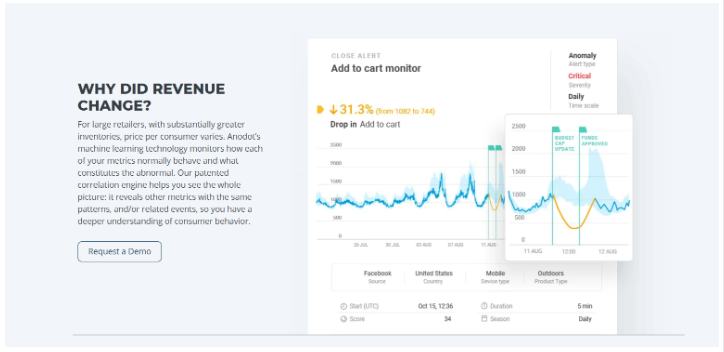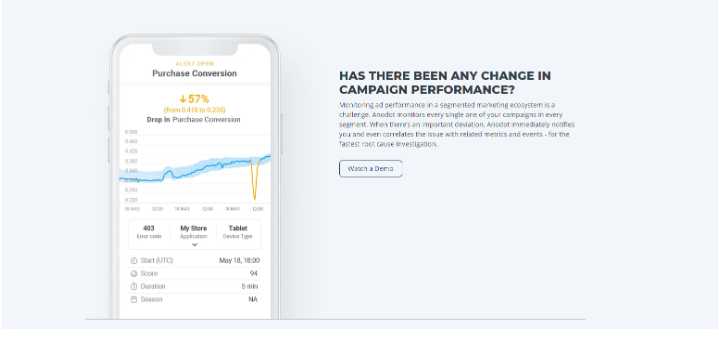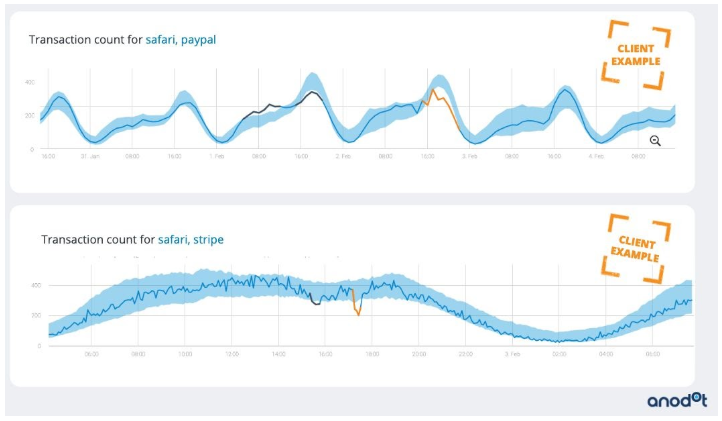As online commerce has boomed, many companies now manage a large number of revenue streams from a variety of sources including micro-transactions, single purchases, and subscription plans.
Now that revenue models have become much more complex and fragmented, many companies have realized that their traditional systems simply aren’t capable of the scale and granularity required for accurate revenue monitoring.
In particular, revenue monitoring often involves tracking thousands of metrics and billions of events simultaneously, including KPIs like conversion rate, advertising performance, and payment processors.
In the past, many companies have tried to feed these business metrics into IT or APM monitoring systems. The reality is, however, these monitoring systems fail to provide accurate alerts in real-time for anomalies that can impact revenue.
To solve this, many businesses have turned to AI and machine learning for their revenue monitoring, and we’re going to discuss exactly what that means for single purchase transactions.
What is Revenue Monitoring?
As mentioned, the complexity and fragmentation of revenue streams have only grown in the digital era. From microtransactions, single purchases, partners, and affiliates, a glitch in any of these revenue streams can have a serious impact on your bottom line. This means that catching anomalous events and reducing your time to resolution is an incredibly high-priority task for many companies.
That’s where revenue monitoring comes in.
Revenue monitoring refers to the process of tracking, measuring, and identifying changes in revenue-related business metrics. Typical examples of revenue monitoring include purchase transaction monitoring, advertising monitoring, payment gateway monitoring, and more.
As you may know, each one of these business KPIs has its own unique behavior over time, and monitoring them often requires tracking billions of events each day.
In the past, many companies relied on setting manual thresholds for when the company should be alerted about spikes or drops in a particular metric. Since revenue-related metrics are driven by human behavior, however, this means that they can fluctuate naturally due to things like seasonality.
To give you a real-world example, as discussed in our guide on Building Consistent Revenue Monitoring with AI, the eCommerce shoe retailer Zappos sold over $500M worth of shoes in 2018. This means that the company is selling tens of thousands of shoes each day, which leads us to the following questions:
- How long will it take them to know if a particular shoe is selling less than expected?
- How can they assess the impact of changes in their conversion rate?
As you can imagine, these questions need to be constantly monitored and answered in real-time.
So how is a company like this solving these revenue monitoring challenges?
The answer that many companies have realized is that AI and machine learning are the only way to monitor this kind of purchase behavior at scale.
AI & Machine Learning for Revenue Monitoring
As discussed, the goal of applying AI and machine learning to revenue monitoring is to be as proactive as possible in catching unusual drops in revenue.
Not only do companies want to catch these significant changes, but they also want to be able to identify the root cause of the anomaly.
To do so, an AI-based anomaly detection solution can be applied to each and every revenue-related metric. A solution like this then learns the normal behavior of every single metric on its own, and within minutes can start monitoring a company’s entire data stream.
In particular, AI-based revenue monitoring can autonomously monitor billions of events for each metric that relates to revenue. The solution can then take this huge amount of data and distill it into a single score. As soon as there’s an anomaly related to a particular data source, the solution alerts the appropriate team in real-time.
As discussed in our white paper on business monitoring, here is the logic that an AI-based revenue monitoring solution employs:
- Unsupervised machine learning is applied to business monitoring: Unsupervised learning refers to a machine learning technique that takes unlabeled data and discovers patterns and structure in the data.
- Real-time monitoring of all data: The monitoring solution is then applied to every data point, as anomalies can occur in various metrics. For example, revenue must be monitored for each product, location, and device. These multiple levels of business data must then be correlated with each other to report on incidents.
- Detection of Seasonality: As mentioned, since revenue is related to human behavior, an AI solution must detect the typical seasonality of each data point in order to prevent false positives, false negatives, and alert storms.
- Anomaly scoring: The AI grades anomalies in order to filter alerts by significance. Each anomaly is evaluated based on their relation to each other, and significant events are flagged and alerted in real-time.
As a result, applying AI to revenue monitoring means you have the lowest possible time to resolution and the least impact on the bottom line.
Use Cases of AI for Single Transaction Revenue Monitoring
Now that we’ve discussed how AI is applied to revenue monitoring, let’s look at some common use cases.
Add to Cart Monitoring
As you may know, Add to Cart data is a leading indicator of revenue, so monitoring it for significant spikes or drops is useful for many companies. In the image below, we can see the AI solution is applied to each traffic source, country, device type, and product type. The AI scores the anomaly and provides a severity rating for changes in the data.
Monitoring Advertising Performance
Another leading indicator for revenue is monitoring advertising performance. Since today’s marketing ecosystem is so segmented, an AI solution can monitor every single one of your campaigns across various devices and platforms. If there is an anomaly, the solution can correlate the issue with related metrics and events so you can identify the root cause in the fastest time possible.
Payment Gateway Monitoring
A final example of revenue monitoring is tracking changes in payment gateways. As discussed in our guide on monitoring payments, this is often one of the overlooked business KPI that impacts revenue. Regardless of which payment provider(s) you use, the provider will expose an API that allows you to monitor these streams in real-time. An AI-based solution will then notify you as soon as you experience a drop in payments from a provider, platform, or any parameter you’ve identified as important.
AI for Revenue Monitoring
As we’ve discussed, revenue monitoring in today’s ecosystem often requires tracking and analyzing billions of events each and every day.
Many companies have realized that traditional IT and APM monitoring solutions simply don’t offer the scalability that’s required to effectively monitor revenue-related metrics.
Instead, companies are turning to AI to be proactive about changes in their revenue and lower their time to resolution when incidents inevitably occur. In particular, an AI-based revenue monitoring solution can learn the usual behavior of each and every metric. The solution can also find correlations in events and metrics so that when you’re alerted of an anomalous event, you’re also provided with a deep root cause analysis.
By identifying incidents before they become issues, AI-based revenue monitoring helps companies save significant amounts of otherwise lost revenue.









